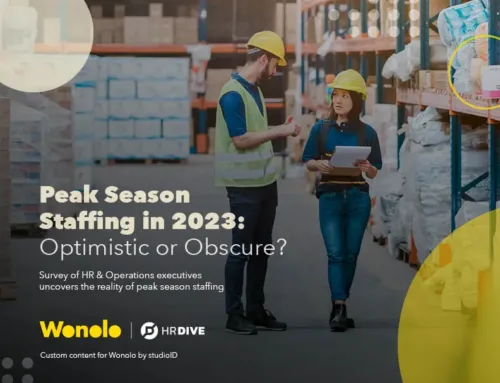Wonolo
The world’s workforce faced a massive upheaval the moment Uber came on the scene. Uber was not the creator of the gig economy, the gig economy had existed for as long as we can remember, but it did signify the “mainstreaming of gigs”.
Uber’s disruption of the transportation industry was powerful not because it got drivers to do gigs, that was already possible. It was powerful because of its powerful use of AI and technology to connect random drivers with the riders via their powerful app. This signified the first most publicized foray of AI into the industry and it quickly became the norm.
The kick in the gut for ride-hailing giants like Uber and Lyft came when many drivers started treating the job as less of a gig and more of a full-time job. Uber had wanted people to use their services to earn a little money by the side, but their drivers soon realized that driving 80 hours or more a week, often gave them a better income than their day jobs.
People started working for ride-hailing companies full time and ditching their jobs. With full-time work, comes the expectations of full-time benefits, something Uber and co were adamant not to give. When cases of assaults, sudden unexplained de-activation of accounts, and a consistent slash in incomes became rampant, drivers began demanding full-time benefits and a change in their recognition from independent contractors to employees. In many ways, these fights are still ongoing despite Uber’s attempts at pacifying the drivers
The battle between ride-hailing companies and their drivers underlines the problems at the heart of the gig-economy with the infiltration of AI. As companies continue to utilize gig workers, they continue to exploit these workers because of their “invisibility”, temporariness and their perceived inability to unionize.
One sad conversation with a driver trapped in this broken ride-hailing system was enough to spur Firdosh Sheikh into starting DRIFE, a ride-hailing company that focuses on delivering a more equal, and ethical ride-hailing experience.
Sheikh’s strong desire to create a business around equity for these drivers led her to start developing a platform that democratizes the ride-sharing industry. The DRIFE model utilizes a powerfully advanced platform that allows drivers to make a livable income by taking 100% of the income home in exchange for a small subscription fee. Riders can also save a lot of money because of the absence of a middleman.
“The ride-hailing debacle of the last 5 years is proof that when tech and AI are utilized without empathy, it can cripple a system that has so much potential,” says Sheikh.
“We, on the other hand, are working hard on DRIFE to show people that technology can deliver equity when used with empathy. Whatever problems technology causes, only technology can solve. This is why the gig-economy will become fairer not with less AI and tech, but with more humane, and equity-minded applications of these technologies ”
AI, And The Gig Economy
Sheikh’s sentiment is popular among the upper echelons of the gig economy. There is a growing resignation to the fact that AI has come to stay and for good reason too, the rampant rise of AI solutions for everything is startling. The solution seems to be found only in a change of perspective.
While it is true that robots and AI-powered systems are replacing workers in the gig economy, it is also true that all the freelance platforms and the platforms that connect gig workers to employers are either already AI-powered or headed in that direction. This means that AI might be providing more jobs than it is taking.
The gig economy might offer companies and businesses cost-efficient options to getting tasks done, but it doesn’t automatically make finding a fit easy. AI-powered platforms have begun utilizing data to help both gig workers and employers find exactly what they need.
AI Creates The Right Fit
The ‘fit’ of a pairing is often the catalyst for more equity and fairness in working conditions. For instance, freelance writing platforms like Clearvoice have perfected their AI-platform matching to enable employers to find the best niche writers for their tasks. This is responsible for why their platform is one of the most profitable for writers.
AI’s ability to analyze and interpret data makes it extremely effective in finding good matches for gig-workers,and companies.
Sheik also highlights this ‘fit’ phenomenon as being one of the reasons DRIFE is set to be so successful; “If people cannot find exactly what they need and what they can afford, then there cannot be fairness in a system. In our model, for instance, a rider can identify all available drivers within a specific radius, but the drivers can send bids to the rider. This enables the rider to pick the best fit for them based on personal parameters, cost, proximity, reputation even gender. This introduces re-negotiations and consequently fairness”
AI Fills the Education Vacuum for Gig Workers
AI is also changing the very nature of certain tasks. The result of this is that many of the people who performed these tasks are no longer qualified to perform their more tech-reliant equivalent.
These AI-inspired evolutions demand that workers in the gig economy continue to upskill and re-skill to find sustained relevance. This need is also met by the deployment of AI-powered learning which makes it easier to pick up micro and macro skills. This only goes to underline Sheikh’s point that only technology can solve the problems it brings.
The proliferation of AI-powered Edtech companies is one reason why the participants in the gig economy are growing fast. These platforms are easy to use, very customized, and cheaper than conventional education or one-on-one learning.
AI Is Improving The Output of Gig-Workers
The most obvious benefit that gig workers get from AI is the targeted marketing of their services via social media. However, AI is also being utilized in more relevant ways.
AI-powered solutions that improve accuracy, check for errors and make smart suggestions to the gig-worker has become invaluable and increasingly available in every area of the gig-economy.
For instance, Grammarly doesn’t only improve the correctness of a freelance writer’s work, it also makes personalized nudges and suggestions on how to make it better.
Several apps are beginning to integrate smart suggestions and personalized nudges that tell the user a feature they might benefit from, or direct them to a resource that might be helpful in the execution of their task.
Every gig worker knows that higher output means a higher ability to charge and earn more.
The Future of AI And The Gig Economy
Sheik is one voice amongst many others who voices optimism for the gig economy.
“More tools, more AI software, and more technology would be built to help the freelancer and the gig economy worker,” says Sheik.
“We are doing exactly that in the ride-hailing industry with DRIFE and many other brilliant entrepreneurs are doing the same in other industries. I think the future of this relationship between AI and gigs is in the creation of more beneficial tools”
The Future is AI-powered. In today’s world, data is king and the ability to understand and manipulate data will give anyone an edge. The gig economy like every other industry will have to evolve.
This article was written by Annie Brown from Forbes and was legally licensed through the Industry Dive publisher network. Please direct all licensing questions to legal@industrydive.com.


![[Report] Beyond the Gig: Exploring Reliable Work Options for the Modern Workforce](https://info.wonolo.com/wp-content/uploads/2023/10/Worker-Preferences-Report-Header-Image-500x383.png)



